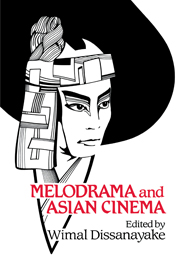Book contents
- Frontmatter
- Contents
- List of contributors
- Acknowledgments
- I Introduction
- II Melodrama / subjectivity / ideology: Western melodrama theories and their relevance to recent Chinese cinema
- III Symbolic representation and symbolic violence: Chinese family melodrama of the early 1980s
- IV The Goddess: Reflections on melodrama East and West
- V Melodrama as historical understanding: The making and unmaking of communist history
- VI Melodrama, postmodernism, and Japanese cinema
- VII Inscribing the subject: The melodramatization of gender in An Actor's Revenge
- VIII Insides and outsides: Cross-cultural criticism and Japanese film melodrama
- IX Psyches, ideologies, and melodrama: The United States and Japan
- X Negotiating the transition to capitalism: The case of Andaz
- XI The concepts of evil and social order in Indian melodrama: An evolving dialectic
- XII Politics of melodrama in Indonesian cinema
- XIII Power, pleasure, and desire: The female body in Filipino melodrama
- XIV The register of nightmare: Melodrama as it (dis)appears in Australian film
- XV Overview: What is American about film study in America?
- Index
VI - Melodrama, postmodernism, and Japanese cinema
Published online by Cambridge University Press: 05 June 2012
- Frontmatter
- Contents
- List of contributors
- Acknowledgments
- I Introduction
- II Melodrama / subjectivity / ideology: Western melodrama theories and their relevance to recent Chinese cinema
- III Symbolic representation and symbolic violence: Chinese family melodrama of the early 1980s
- IV The Goddess: Reflections on melodrama East and West
- V Melodrama as historical understanding: The making and unmaking of communist history
- VI Melodrama, postmodernism, and Japanese cinema
- VII Inscribing the subject: The melodramatization of gender in An Actor's Revenge
- VIII Insides and outsides: Cross-cultural criticism and Japanese film melodrama
- IX Psyches, ideologies, and melodrama: The United States and Japan
- X Negotiating the transition to capitalism: The case of Andaz
- XI The concepts of evil and social order in Indian melodrama: An evolving dialectic
- XII Politics of melodrama in Indonesian cinema
- XIII Power, pleasure, and desire: The female body in Filipino melodrama
- XIV The register of nightmare: Melodrama as it (dis)appears in Australian film
- XV Overview: What is American about film study in America?
- Index
Summary
Melodrama has been one of the film genres that have been extensively studied and analyzed in the past two decades. Because of the enormous popularity of this generic form in the classical period of the American film industry, the examination of melodramatic film seems to contribute to a general study of the Hollywood cinema as an institution of industrial capitalism. Because women have been the major focus of melodramatic film both as the audience and as characters, a study of melodrama also constitutes an important part of feminist film theory. And some critics have chosen to study melodrama in order to reexamine the relation between the masses and mass culture. They try to demystify the popular belief that melodrama is nothing more than a vehicle of escapism for the masses; they have uncovered in melodrama's stylistic hyperbole and exaggeration not the logic of escapism but a critique of ideology that melodramatic film is said to be propagating. In his classic essay on melodrama, Thomas Elsaesser demonstrates how a critique of American middle-class ideology of the 1950s is made in the films of Douglas Sirk through the process of condensation and displacement found in the hyperbolic use of objects and colors. He goes beyond a mere formal analysis of Sirk's films by placing them in a specific sociopolitical background of the 1950s' America. What Elsaesser's essay teaches us is that the examination of melodrama as a generic form becomes meaningful only if particular texts of melodrama and their subtexts are analyzed simultaneously.
- Type
- Chapter
- Information
- Melodrama and Asian Cinema , pp. 101 - 126Publisher: Cambridge University PressPrint publication year: 1993
- 10
- Cited by

